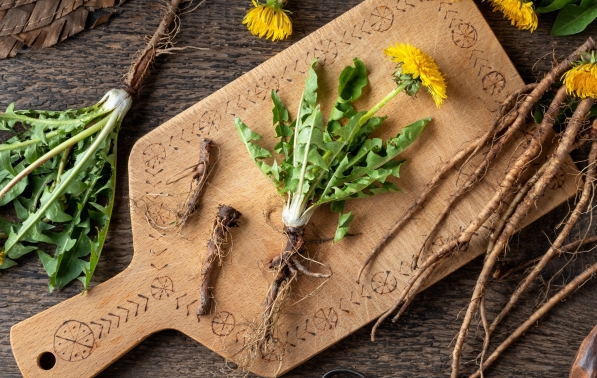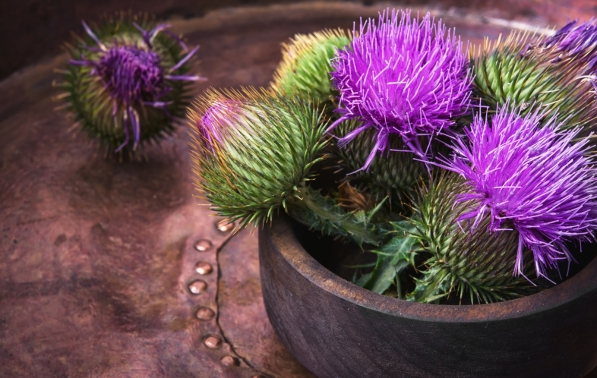Herb Profile: Dandelion Root
April 02, 2024 | 0 comments
by Wendy Wilson
The scientific name for Dandelion is taraxacum officinale, but you will probably recognize it growing in large fields or your yard.
Dandelion root, often dismissed as a weed, holds a treasure trove of health benefits. While commonly found dotting lawns and fields, this root has been utilized for centuries in traditional medicine practices across various cultures. Rich in vitamins A, C, and K, as well as minerals like iron, calcium, and potassium, dandelion root packs a powerful nutritional punch. Its health benefits include supporting liver health by aiding detoxification processes, promoting digestion while relieving digestive issues, and properties to remove toxins from the body. Furthermore, some studies suggest that dandelion root has cancer-fighting and antioxidant properties, which contribute to improved immune function and reduced risk of chronic diseases.
WHAT IS DANDELION ROOT?
The scientific name for Dandelion is taraxacum officinale, but you will probably recognize it growing in large fields or your yard. If you look at the dandelion plant it is structured in such a way to capture to its advantage the resources of the planet. There are hundreds of dandelion species that grow in varied climates all over the world such as Europe, Asia, and North America.
The leaves of the dandelion plant are smooth, sculptured, and notched creating a deep grove or funnel-like surface to transport more moisture to the roots. The tall majestic stem is crowned with a bright, yellow flower that opens and faces the sun in the morning and closes again in the evening. The roots of the dandelion plant are brown, fleshy, and fragile. Some roots are harder than tree bark and some are soft and brittle under pressure. Inside the roots of the dandelion plant is this river of white, milky substance. This substance does not taste like milk but is bitter and has a unique aroma; sort of a sweet, flowery, and nutty taste.
The dandelion took on its notorious weed rap sheet when the love of the lawn came into vogue. Dandelion has turned out to be the weed from hell for the lawn enthusiast. No matter what poison is used on it the dandelion keeps coming back. The availability of dandelion is fairly secure. Each plant produces over 5,000 parachute-type seeds in a puffy ball, perfectly engineered to lift off when even the smallest air current presents itself.
NUTRITIONAL PROPERTIES
Each part of the dandelion has been used for thousands of years for various health conditions. Persia seems to have the earliest writings of using dandelion plants for medicinal purposes. The leaves have been used as a diuretic and to stimulate appetite – often put into salads to also improve digestion. The dandelion flower delivers antioxidants and helps the immune system.
The nutrition in dandelion is probably why insects (honey bee, wasp, bumblebee, hornet, grasshoppers, fireflies, and butterflies), mammals (deer and rabbit), and birds (goldfinch, bobwhite, wild turkey, and sparrow) will flock to this plant to partake of its healthy green properties. Mammals and insects will eat the leaf only. While most humans look at the dandelion as a nuisance, many are taking a second look at this plant as a beneficial food source.
Many grocery stores will offer dandelion sprouts or greens for your salad. Dandelion is a pretty safe plant as it also offers antibacterial properties to the consumer. In ancient times the flower of the dandelion was used to make wine and the roots were made into a coffee-like beverage. In the ancient world, dandelion was used to improve digestion, liver function, purify the blood, reverse rheumatism and expel kidney stones, and more.
If you plan to utilize the dandelion plant as a food source there are a few tips that will make your experience more pleasant. For fresh spring salads use the smaller, tender leaves. Rinse and add to your salads. The larger, older leaves will be tougher and will need to be steamed first. Reserve the young and tender flowers of spring for teas, jellies, and wines.
Rule-of-thumb is to harvest your dandelion root during frost-free periods of the fall when the bloom is gone and the nutrients return to the roots. You can clean the roots and eat them raw, dry them, and power them for a coffee product. Or, use your roots to make a medicinal dandelion root tincture and allow to age for at least 30 days before straining and pressing. For recipes for dandelion tea and coffee see http://naturesbeautysecrets.me/diverse-dandelions-how-to-make-dandelion-tea-and-coffee/
If you are in the market for a potent, nutrient-rich extract of dandelion root, we recommend using the Dandelion Root.
“Good medicine always tastes bitter.” Confucius
MEDICINAL USES
Recently the medical researchers at Windsor University in Canada discovered its cancer-fighting benefits. Most natural healers know that bitter herbs contain organic compounds to help stimulate the body to heal itself. Dandelion has those bitter compounds called saponins and sesquiterpene lactones. One of the medicinal advantages dandelion offers is its abundance of minerals (more than spinach).
According to research chemist, Mark Pedersen, dandelion (especially the root) has a very balanced mineral profile. It is high in beta-carotene (vitamin A) which is stored in the liver. Dandelion has been known to assist with inflammation, muscle spasms, and fluid retention. Dandelion can accomplish that while it soothes the digestive tract and helps to balance gut flora because it contains inulin and pectin, which are mucilage compounds.
HOW SETTLERS USED IT
What did the American settlers do about dandelion? They used it as a food source because they are delicious and nutritious. They spruced up salads with this golden plant, made spring-time tonics and teas to sweep away the winter blues, and made dandelion wine and jelly (lemony and floral taste). Want to make some? Here’s how: http://herbgardens.about.com/od/herbrecipes/ht/Dandelionjelly.htm.
IMPORTANT NOTE: the dandelion you use for food should be free from chemicals.
There is no doubt that dandelion offers some cleansing benefits and that is why settlers used the plant after a long winter of heavy meats and beans. You will often see dandelion in herbal cleansing formulas. The health benefits and versatile uses of dandelion root make it a valuable addition to any wellness practice. Whether brewed into a soothing tea, incorporated into salads, or taken as a supplement, its nutrient-rich composition offers support for various aspects of health, from digestion and detoxification to immune function and beyond.
Embracing the power of dandelion root not only harnesses the wisdom of ancient healing traditions but also aligns with scientific research, affirming its status as a potent natural remedy. So why not take a step towards enhancing your well-being by exploring the wonders of dandelion root today? You will find dandelion root in many of the formulas at Apothecary Herbs as well as an aged concentrate of Dandelion Root all by itself.
*The information contained herein is not intended to diagnose, treat, prevent, or cure disease. Seek medical advice from a licensed medical physician before using any product or therapy.*
Sources:
https://circulatingnow.nlm.nih.gov/2016/06/07/the-dandelion/
https://www.ncbi.nlm.nih.gov/pmc/articles/PMC5341965/
http://windsorstar.com/news/new-research-fruit-extract-may-cause-cancer-cells-to-kill-themselves
http://windsorstar.com/health/first-cancer-clinical-trial-approved-for-windsor
www.nutrition-and-you.com/dandelion-herb.html
https://www.sciencedaily.com/releases/2013/11/131122103901.htm



